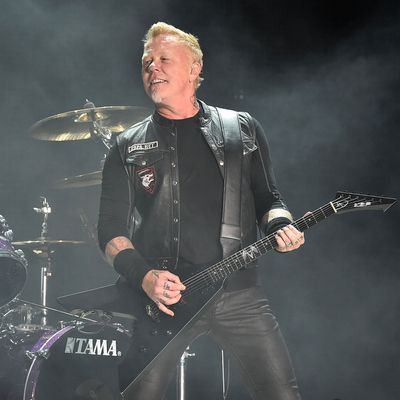
Metallica brought its WorldWired Tour to Nassau Veterans Memorial Coliseum in Uniondale last night, in celebration of this past November’s excellent Hardwired … to Self-Destruct. The performance showcased newer music while appeasing fans who’d come to see their childhood favorites, honoring the past while celebrating the present. The spectacle was airtight proof of the band’s enduring power and professionalism, while the stage setup benefited everyone from the moshing masses in general admission to people seated closer to the ceiling than the floor. You don’t stay relevant in metal for 36 years without learning how to make every seat count.
Metallica played fast in its ’80s thrash-metal heyday but still found ways last night to move even faster. The machine-gun midsection of the Dalton Trumbo homage “One” struck like munitions fire, and even ostensibly slow songs like “Sad But True” quickened their step. Faster timing didn’t make the night shorter. The band played for nearly two-and-a-half hours almost nonstop, with songs sometimes stretching out past the ten-minute mark. (Check out footage of live versions of the Hardwired highlight “Now That We’re Dead,” which slowly devolves into a drum jam where singer James Hetfield leads the quartet in a lengthy call-and-response that transitions right back into the song.) The speed was a gracious attempt to fit in as many songs as possible and a testament to the fury of a metal titan that, while it seems to be slowing its roll, will never ease up on tempo.
Metal is a nostalgic culture with a deep, lasting reverence for architects and innovators. Metallica could eat forever off the stretch of classics from 1983’s Kill ’Em All to 1986’s Master of Puppets, the labyrinthine tracks from … And Justice for All, as well as the more commercial hits of 1991’s “Black Album,” subsisting on the indispensable devotion of a still-huge fandom. They’ve chosen to keep pushing and changing, though, sometimes at the cost of a measure of diehards’ respect, which is what happened when they released the questionable but wildly successful late-’90s hard-rock makeover pushed on the too-long Load and Reload albums. Hardwired, like 2008’s Death Magnetic, finds Metallica revisiting the punishing multi-movement workouts of its first decade, carefully balancing stasis and change without falling prey to self-parody.
The set tested Hardwired’s mettle against 30-year-old Metallica classics. (That polarizing stretch between Load and 2003’s St. Anger was largely avoided, barring lead guitarist Kirk Hammett and bass player Robert Trujillo’s dual rendering of the Mission Impossible 2 soundtrack cut “I Disappear.”) The pummeling “Hardwired” and “Atlas, Rise!” were as ferocious opening the show as they were on the album. Everything from the Black Album sparked a frenzy. “Enter Sandman” and “Sad But True” crushed; and lighters were lifted during “The Unforgiven” and “Nothing Else Matters.” The set-ending streak of “One,” “Master of Puppets,” “Fade to Black,” and “Seek and Destroy” was the gig’s powerful, unrelenting peak, with respect to an unexpected run through Master of Puppets’ epic “Welcome Home (Sanitarium).”
The band performed on a diamond-shaped rig in the middle of the coliseum floor with fans on all sides. Drummer Lars Ulrich’s kit was elevated on a circular stand that pivoted 90 degrees every few songs. Hetfield and Trujillo traded vocals on microphone stands stationed at various points along the edges of the stage, while Hammett shredded everywhere in between. It was a democratic arrangement that ensured everyone in attendance enjoyed a little face time. The band performed on top of a giant screen displaying video loosely tied to each song’s subject matter. Down below, it often looked like a blur of color, but if you were seated higher up in the coliseum, the screen bolstered the performance with hellish visuals.
Metallica didn’t need to have a slick light show on top of all this but still delivered. The intro to “One” combined smoke with yellow laser flashes and the sound of gunfire, re-creating a scene of war to match the song’s reimagining of Trumbo’s Johnny Got His Gun. Elsewhere, giant lightbulbs at the corners of the stage periodically gave the appearance of a campfire. The lights created otherworldly scenes to match Hetfield’s dark lyrics, and just when it looked like they’d run out of production tricks, closer “Enter Sandman” blew in on a shock of fireworks. It’s a good metaphor for a band still going strong its fourth decade of existence: Whenever you get it into your head that Metallica has shown you everything it’s capable of, it reaches out with just a little more.


